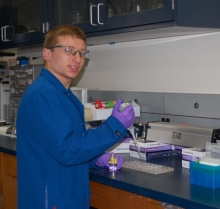
Major:
University:
Mentor(s):
Faculty Sponsor(s):
Faculty Sponsor's Department(s):
Project Title:
Project Description:
Polymer hydrogels are viscoelastic materials consisting of a flexible, crosslinked network that is highly swollen with water. In particular, “smart” hydrogels, in which the swelling of the polymer matrix changes with differences in environmental stimuli (temperature, pH, light exposure, salt concentration, etc.) are highly desirable for potential applications in fields such as drug delivery, microfluidics, tissue engineering and catalysis. Poly(ethylene glycol) diacrylate (PEGDA) is an inexpensive, easily crosslinked, biocompatible hydrogel-forming polymer that provides a versatile platform for hydrogel design. However, PEGDA itself does not exhibit stimuli-responsive behavior. To overcome this limitation, we study the incorporation of two ionizable co-monomers, 2-(dimethylamino)ethyl methacrylate (DMA) and 2-carboxyethyl acrylate (CEA) into PEGDA hydrogels, and characterize their effect on the pH-dependent equilibrium swelling of bulk hydrogels. Our results show that incorporation of basic co-monomer DMA increases swelling at low pH levels and reduces swelling at high pH levels, whereas the opposite trend is observed for gels copolymerized with CEA, in agreement with theoretical predictions. These effects are exaggerated with increasing co-monomer content in the hydrogel. However, we find this differential swelling to be dependent on the PEGDA macromer concentration. Specifically, gels made from 0.7 kg/mol PEGDA exhibit significantly greater degrees of pH-differential swelling compared to those made from 10 kg/mol PEGDA. We hypothesize that this behavior is due to reduced incorporation of co-monomer into hydrogels of higher PEG chain length. Our findings call for studies of pH-responsive swelling in nanoscale hydrogels.
